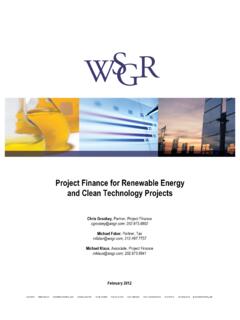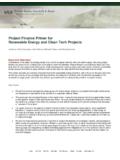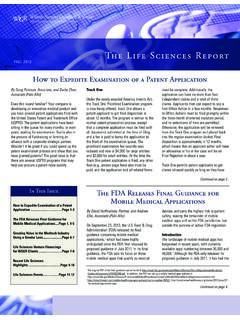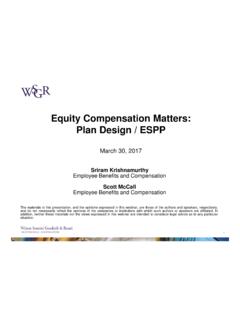Transcription of Project Finance Primer for Renewable Energy and Clean …
1 Project Finance Primer for Renewable Energy and Clean Tech Projects Authors: Chris Groobey, John Pierce, Michael Faber, and Greg Broome Executive Summary Investments in the Clean technology sector often combine capital intensity with new technologies. Securing Project Finance can prove to be a critical step in the path to commercialization. Project Finance succeeds best when you have long-term off-take agreements with quality-credit counterparties (such as power purchase agreements) but commodity-based projects that sell into open markets (such as biofuels) can also benefit from the Project Finance model.
2 This Primer provides an overview of Project Finance for Renewable Energy investors, with a focus on the pros and cons, as well as a survey of key concepts and requirements, including tax incentives and monetization strategies in the Renewable Energy sector, and other key structuring considerations in determining whether to Project Finance . Key Points Project Finance has emerged as a leading way to Finance large infrastructure projects that might otherwise be too expensive or speculative to be carried on a corporate balance sheet.
3 The basic premise of Project Finance is that lenders loan money for the development of a Project solely based on the specific Project s risks and future cash flows. As such, Project Finance is a method of financing in which the lenders to a Project have either no recourse or only limited recourse to the parent company that develops or sponsors the Project . For equity investors, the appeal of Project Finance is that it can maximize equity returns, move significant liabilities off balance sheet, protect key assets and monetize tax financing opportunities.
4 A wide range of commercial and legal issues must be addressed to secure adequate returns. Tight credit markets exacerbate competition for long-term financing, so even small differences in deals can impact the availability of financing or reduce leverage. Project financing became particularly important to Project development in emerging markets, with participants often relying on guarantees, long-term off-take or purchase agreements, or other contractual relationships with the host sovereign or its commercial appendages to ensure the long-term viability of individual projects.
5 These were typically backstopped by multilateral lending agencies that mitigated some of the political risks to which the Project lenders were exposed. Analogies to alternative Energy projects help investors de-risk higher-risk new technologies. Austin New York Palo Alto San Diego San Francisco Seattle Shanghai Washington, I of the Primer introduces Project Finance to those that may be less familiar with the concept, and asks questions that will assist investors and developers in determining whether Project Finance is appropriate for their Renewable Energy projects.
6 Part II sets out the legal and contractual structure that will facilitate Project financing. Part III describes the process of obtaining equity investment and some of the important options and considerations that companies may have in that process. Part IV provides a more in-depth look at what a typical Renewable Energy Project financing looks like, including fundamental structural components that characterize any Project Finance transaction. Finally, Part V outlines key tax incentives currently available in the Renewable Energy industry, as well as monetization strategies that may be useful for earlier-stage Energy companies unable to directly utilize such tax incentives.
7 Given the breadth of the current Renewable Energy landscape, this Primer focuses on a hypothetical solar generation facility ( Solar Project ) as the primary case study with discussions of other Renewable Energy projects (wind power and biofuel projects in particular) as appropriate. In general, once the contracts related to a Project are negotiated (which is described in Part II), the mechanical aspects of raising equity and Project financing are likely to be similar across various Renewable technologies, although investor enthusiasm and financing prices and terms are likely to vary significantly across technologies at any given time.
8 I. Introduction to Project Finance A. What Is Project Finance ? The basic premise of Project Finance is that lenders loan money for the development of a Project solely based on the specific Project s risks and future cash flows. As such, Project Finance is a method of financing in which the lenders to a Project have either no recourse or only limited recourse to the parent company that develops or sponsors the Project (the Sponsor ). Non-recourse refers to the lenders inability to access the capital or assets of the Sponsor to repay the debt incurred by the special purpose entity that owns the Project (the Project Company ).
9 In cases where Project financings are limited recourse as opposed to truly non-recourse, the Sponsor s capital may be at risk only for specific purposes and in specific (limited) amounts set forth in the Project financing documentation. Project financing has been used in various ways for many years, but in the 1970s and 1980s it emerged as a leading way of financing large infrastructure projects that might otherwise be too expensive or speculative for any one individual investor to carry on its corporate balance sheet. Project financing has been particularly important to Project development in emerging markets, with participants often relying on guarantees, long-term off-take or purchase agreements, or other contractual relationships with the host sovereign or its commercial appendages to ensure the long-term viability of individual projects.
10 These were typically backstopped by multilateral lending agencies that mitigated some of the political risks to which the Project lenders (and, sometimes, equity investors) were exposed. B. What Underpins Project Finance ? As a general (if not universal) rule, lenders will not forgo recourse to a Project s Sponsor unless there is a projected revenue stream from the Project that can be secured for purposes of ensuring repayment of the loans. In the case of large wind and solar power projects, this revenue is typically generated from a power purchase agreement ( PPA ) with the local utility, under which the Project may be able to utilize the creditworthiness of the utility to reduce its borrowing costs.














